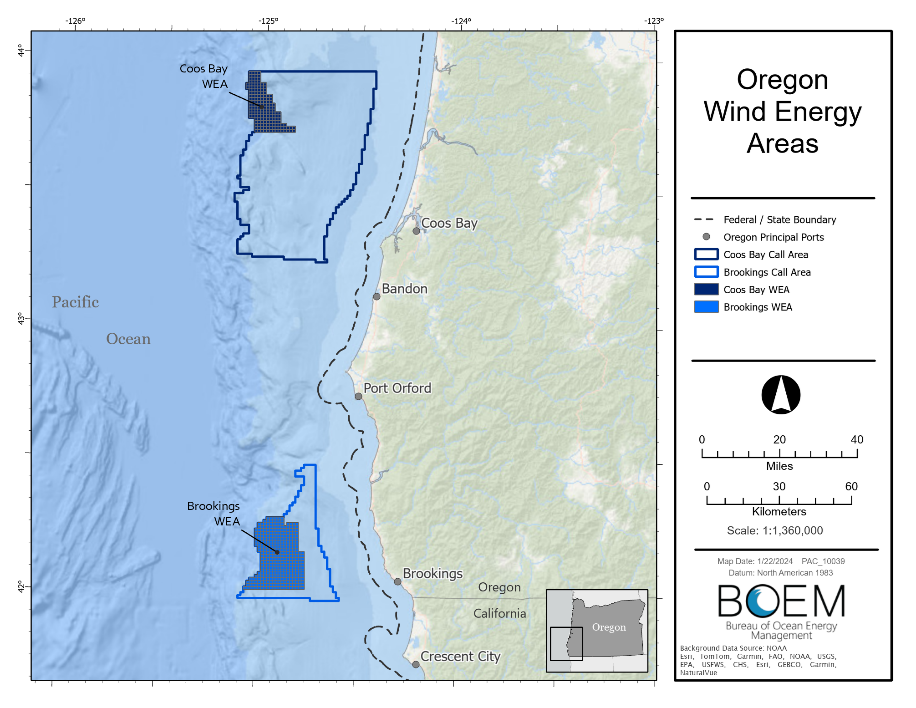
By LYNNE TERRY/Oregon Capital Chronicle
Three of Oregon’s congressional members are pushing the federal government to extend the comment period on two proposed wind power projects off the southern Oregon Coast.
The Bureau of Ocean Energy Management announced last month it was moving forward with plans for offshore wind power installations off Coos Bay and Brookings. As a first step, the agency said on Feb.14 it would conduct an environmental assessment and gave the public 30 days to comment. The comment period ends Friday.
Sens. Ron Wyden and Jeff Merkley and Rep. Val Hoyle, all Democrats, said residents need more time according to input they’ve received. In a letter on Tuesday, they asked the agency’s director, Elizabeth Klein, to extend the comment period to give Oregonians who would be affected by the offshore sites a chance to fully engage in the process.
“Tribes, the fishing community and others throughout Oregon’s coastal communities are currently working to develop comments that will inform the environmental assessment for the wind energy areas, including impacts to the ocean ecosystem, environment, fisheries, viewsheds and other important resources,” they said. “We request an extension of the comment period to allow for robust comments that will set the most complete stage for future analysis. We believe that an extension will serve the tribes, coastal and fishing communities, and ultimately BOEM by allowing ample time to prepare meaningful scoping comments.”
The sites are part of the Biden administration’s plan to build up 15 gigawatts of floating offshore wind energy capacity by 2035, with a total of 30 gigawatts deployed by 2030. Oregon and California on the West Coast are among nearly 20 states nationwide – including states on the Gulf of Mexico and the Atlantic Ocean – that the bureau is working with to develop wind energy sites. As of mid-November, the agency had approved six sites, all on the East Coast. The most recent approval was for a project to power 700,000 homes in New York and New Jersey.
Last year, the Bureau of Ocean Energy and Management gave Oregonians several months to comment on the agency’s plans, and nearly 1,000 people weighed in. Agency officials also visited Brookings, Gold Beach and Coos Bay last fall to talk to fishing groups, officials and residents about installing wind turbines offshore. But those meetings did not give everyone who would be affected by the installations enough time for “a full and healthy exchange of ideas and concerns,” the letter said.
The two wind energy areas would add 2.4 gigawatts of clean power – enough to power about 830,000 homes – with the installations covering more than 195,000 acres in total. The Coos Bay site would span about 61,200 acres and be located more than 30 miles from shore, while the Brookings site would cover about 133,808 acres and float about 20 miles from shore.
Bureau officials said in developing plans for sites nationwide, it maps where the strongest winds are; the location of shipping lanes, undersea cables and submerged platforms; areas where commercial and recreational fishing are concentrated; areas that are home to wildlife and fragile habitat; and the impact on views.
Still, some fishing groups and tribes are against the development of wind energy in the area. Trawlers are worried the sites could affect their livelihood by restricting trawling, and local tribal members whose ancestors have lived along the southern Oregon coast for centuries are also worried about fishing. In November, the Tribal Council of the Confederated Tribes of the Coos, Lower Umpqua and Siuslaw Indians passed a resolution saying it opposes offshore wind energy development because the agency had failed to respond to its concerns.
“The tribe has consistently raised concerns about wind energy development. These comments include a request that important, cultural viewsheds be excluded from the (wind energy sites) and that wind development avoid areas critical to resident and migratory species, including important areas for fishing,” the council said.
How to comment: Oregonians can comment through Friday on the proposed sites by going here



